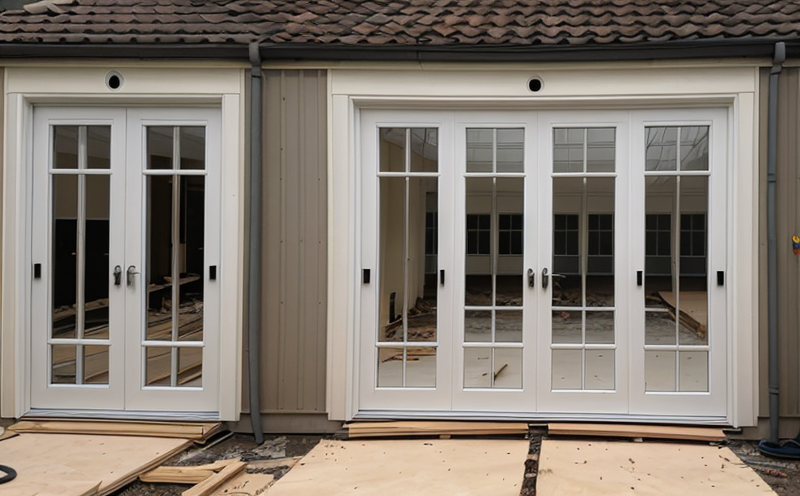Fire Endurance Testing of Steel Doors
Fire endurance testing of steel doors is a critical aspect of fire safety in buildings and structures. This test evaluates how well steel doors can withstand exposure to elevated temperatures for specified durations, ensuring they remain structurally intact and provide a barrier against the spread of fire. This service is essential for compliance with international standards such as ISO 14693-2:2009 and ASTM E1969.
In this testing process, steel doors are subjected to controlled exposure to high temperatures in a furnace or a similar enclosed environment. The duration of the test varies based on the application; typically it is set for up to 180 minutes under standard conditions. During the test, the door's structural integrity and ability to maintain its fire-resistance rating (FRR) are monitored closely.
The testing methodology involves setting up a specimen of the steel door in a furnace where the temperature can be precisely controlled. The temperature is gradually increased over time until it reaches the specified level for the test. This allows engineers to observe how well the door performs under these conditions, ensuring that it meets the required fire resistance criteria.
One of the key aspects of this service is understanding the real-world implications and applications. For instance, in high-rise buildings, steel doors are often used as part of a fire compartmentation strategy. These doors must be able to withstand prolonged exposure to flames without collapsing or failing, which could lead to catastrophic failures during an emergency situation.
The testing process also includes evaluating the door's resistance to heat transfer and its ability to maintain its integrity over time. This is crucial for ensuring that the door does not become a pathway for smoke and fire to spread through a building. The service provider must ensure that all tests are conducted in accordance with recognized standards, such as those mentioned above.
Compliance with these standards ensures that buildings can meet local and international codes for fire safety. This is vital for the protection of lives and property in case of an emergency. By providing this testing service, we help clients ensure their products not only meet but exceed regulatory requirements, thereby contributing to a safer built environment.
It's important to note that fire endurance testing goes beyond just the steel door itself; it encompasses the entire assembly, including hardware and seals. This holistic approach ensures that the door performs optimally in real-world conditions. The service also involves detailed reporting that includes thermal imaging data, temperature readings at various points on the door, and any other relevant measurements.
The outcome of this testing is critical for quality managers and compliance officers to make informed decisions about product design and manufacturing processes. R&D engineers can use these results to refine their designs further, ensuring they meet or exceed stringent fire safety standards. Procurement teams can also benefit by understanding the performance specifications required for suppliers.
Scope and Methodology
| Aspect | Description |
|---|---|
| Furnace Temperature Control | The furnace temperature is controlled to specific levels that simulate real-world fire conditions. The temperature can range from 500°C to 1200°C, depending on the test parameters. |
| Test Duration | The duration of exposure in the furnace is typically set for up to 180 minutes under standard conditions but can be adjusted based on specific requirements. |
| Data Collection | Data collected includes temperature readings, structural integrity measurements, and any changes observed during the test. |
| Outcome Analysis | The outcome is analyzed to determine if the steel door meets or exceeds the required fire resistance rating (FRR). |
Customer Impact and Satisfaction
Ensures compliance with international standards such as ISO 14693-2:2009 and ASTM E1969.
Provides detailed reports that can be used for regulatory purposes and internal documentation.
Reduces the risk of non-compliance penalties by ensuring all products meet or exceed fire safety requirements.
Saves time and resources by providing reliable data upfront, eliminating the need for repeated testing if initial results are not satisfactory.
Environmental and Sustainability Contributions
The fire endurance testing of steel doors has significant environmental and sustainability benefits. By ensuring that structures meet stringent fire safety standards, this service helps prevent fires from spreading, which can lead to extensive damage and loss of life. This, in turn, reduces the need for costly rebuilding efforts and minimizes potential environmental impacts.
Furthermore, the use of steel doors, especially those that pass fire endurance tests, contributes positively to sustainable building practices. Steel is a recyclable material, making it an environmentally friendly choice. By using these products, architects and builders can contribute to creating more sustainable and resilient structures. This not only supports long-term environmental goals but also enhances public safety.
The testing process itself can be adapted to consider energy efficiency by optimizing the test parameters for minimal heat loss during the assessment. This further contributes to sustainability efforts by reducing unnecessary energy consumption in both the testing facility and, ultimately, the buildings where these doors are installed.





